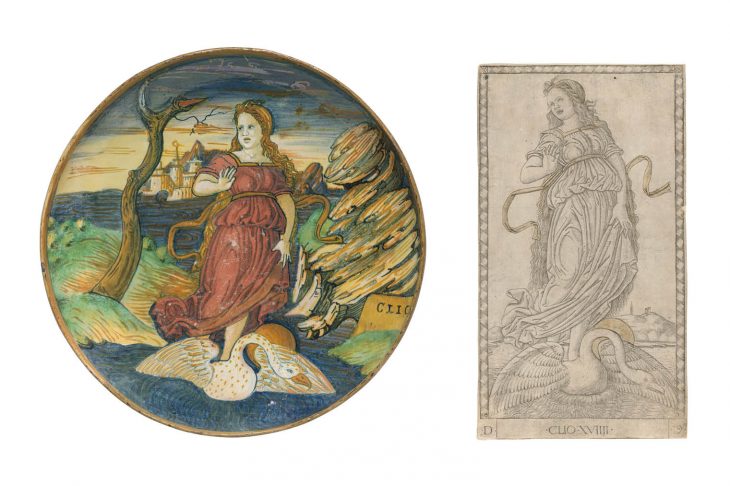An exhibition about Renaissance prints, maiolica, and bronze plaquettes perhaps requires some explanation. It may sound preciously obscure, even to art historians, until one sees the objects side by side. Then a whole rich world of connections, networks and influences emerges. Today, the three media – all relatively unfamiliar, and seldom exhibited together – may appear disparate, but in the Renaissance they shared the same cultivated owners, the same refined spaces, and, crucially, the same designs.
‘Sharing Images’ is the culmination of a research project I began as the Andrew W. Mellon postdoctoral curatorial fellow at the National Gallery of Art in Washington, D.C. When I started my fellowship, the gallery was still in the process of absorbing the holdings of the now sadly defunct Corcoran Gallery of Art. In addition to holding some of the great masterpieces of American art, the Corcoran was also home to a renowned collection of Renaissance maiolica, donated in 1926 by the heirs of the notorious US senator and railroad tycoon William A. Clark. This strong group of around 100 objects joined a smaller but equally refined collection of Italian ceramics that Joseph E. Widener had given to the gallery in 1942. At a stroke, the gallery’s maiolica collection became among the best in the country. Thanks to the Kress gift, the National Gallery’s collection of plaquettes has long been unparalleled in the United States. It was through my expertise in Renaissance prints, however, that I approached this material.
It is often said that the development of prints in the mid 15th century had a profound effect on the history of art, yet such claims tend to remain vague. The main reason is that it is hard, if not impossible, to delineate with precision the boundaries of such a vast phenomenon. But the study of the two media most prominently influenced by prints – istoriato maiolica (ceramics decorated with narrative images and recognisable subjects) and bronze plaquettes – provides a visually exciting and nuanced introduction. When viewed together, these works of art begin to reveal, at a granular level, the workings of a technological revolution that transformed the way Europeans shared and consumed visual information. Prints created and propagated a common visual canon, transcending the confines of local or national traditions. In the age of print, art became truly European.
Print scholars have not traditionally been interested in ceramics and decorative arts – although I hope this exhibition will convince them they should be. Ceramic historians have long known about and studied the connections between prints and the paintings that grace the surfaces of istoriato maiolica, while the best plaquette catalogues frequently allude to the visual sources behind these small-scale but powerful sculptural works. This time, I wished to approach the subject from the other side: what could this rich repository of information tell us about prints?
Take, for instance, the charming lustred bowl painted in Gubbio in around 1535–40 in the workshop of Maestro Giorgio Andreoli, depicting the muse Clio. The female figure riding on a swan, ribbons of fabric fluttering around her, was copied from one of the so-called Mantegna Tarocchi, a set of 50 engravings depicting gods, muses, liberal arts, planets, and social hierarchies, probably made in Ferrara in around 1465. The fact that these images were still current 60 years later, in the age of Michelangelo and Parmigianino – whose designs also appeared on maiolica at the same time – raises important questions about the collecting and circulation of prints. One might be tempted to think that Maestro Giorgio acquired older, out-of-fashion prints because they were cheaper, or that the prints took longer to reach the provincial Umbrian town, but these possibilities are contradicted by another plate in the exhibition, based on a different engraving from the same set, and painted in Deruta, perhaps as early as the 1470s.
The Prodigal Son (c. 1496), Albrecht Dürer (National Gallery of Art, Washington, D.C.); Dish depicting the Prodigal Son (1525), workshop of Maestro Giorgio Andreoli, Gubbio, Italy (The Metropolitan Museum of Art, New York)
Another masterpiece, painted in Maestro Giorgio’s workshop in 1525 and on loan from the Lehman Collection at the Metropolitan Museum of Art, bears witness to the influence in Italy of prints by Albrecht Dürer in the artist’s lifetime. The exquisite lustred plate of the Prodigal Son, something of an icon of the exchanges between Italy and the north, reveals that the unknown painter may not have had access to Dürer’s original engraving, but only to a reverse copy, explaining the opposite orientation of the image. Not every print was created equal, and the immediate fame of Dürer’s engravings may have quickly placed them out of the reach of humbler artists in Italy. Through copies, however, the image spread: the Lehman plate is one of three extant 16th-century iterations on maiolica, all produced in different workshops.
I hope the exhibition will show that copies of prints in other media are not just fodder for footnotes. They are vivid markers of their material presence in artists’ workshops, traces of capillary diffusion and evidence of continued admiration. They are also the most captivating demonstration of how shared images transformed the world around them. In our meme-obsessed times, there is still much they can teach us.
‘Sharing Images: Renaissance Prints into Maiolica and Bronze’ is at the National Gallery of Art, Washington, D.C., until 5 August.
From the May 2018 issue of Apollo. Preview and subscribe here.
